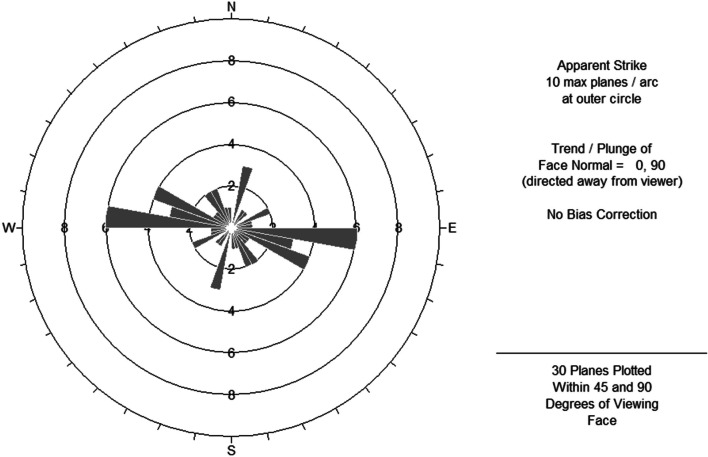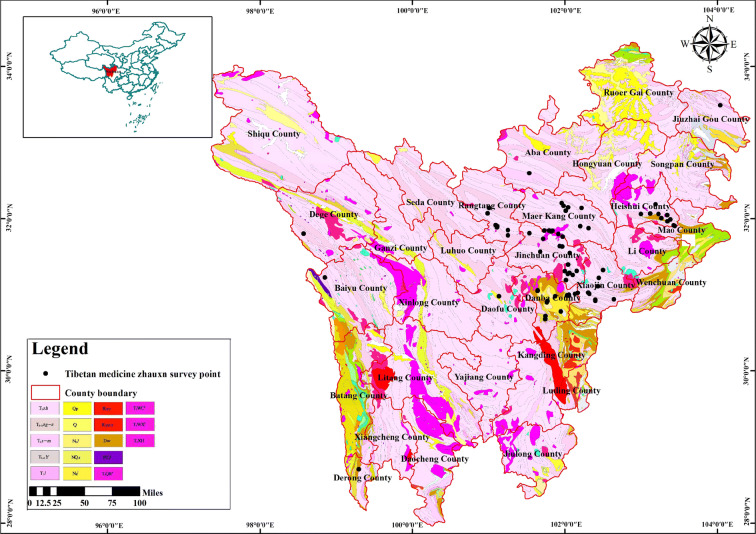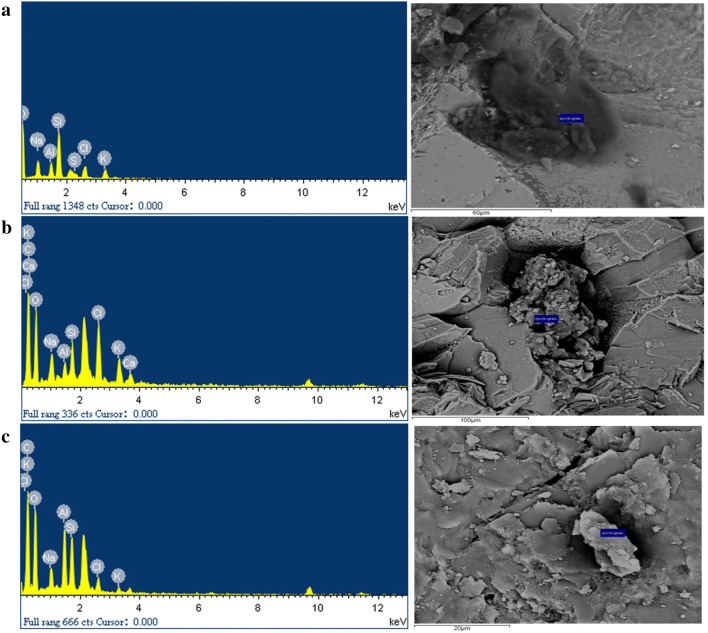Abstract
Background
Shilajit is a commonly used Tibetan medicine, and its water extract is mainly used for various heat-related syndrome, especially that of stomach, liver and kidney. Shilajit is found to exudate from rocks of cliff at an altitude of 2000–4000 m as a water-soluble mixture of black paste and animal feces of Trodocterus spp. or Ochotona spp. Because it is difficult to reach the exudation points so as to explain the its formation process, the source of Shilajit still remains unclear and controversial, which severely impedes its safety and efficacy in clinical application.
Methods
In this work, a series of investigations as rock flakes identification, porosity determination, rock mineral analysis, scanning electron microscopy (SEM), and energy dispersive spectrometer (EDS) have been carried out to clarify the source of Shilajit, including the storage condition and exudation process of its organic matter, and to investigate the geological structure of the exudation points as well as physical and chemical characteristics of the mother rocks.
Results
The Shilajit exudation points were mainly distributed on the steep cliffs, where there were cavities and sections that could not be eroded by rainwater. The fundamental structure of the exudation points was determined by the rock’s bedding planes, joints, fracture surfaces and faults, and developed into micro-topography later. The exudation points were distributed in the Triassic strata and scattered in the Early Mesozoic granitoids. The lithologic features were mainly slate, carbonaceous slate and sandy slate etc. The background rocks were characterized by intergranular pores, dissolved pore, joint and fracture development. Organic matter was widely distributed in these pores and fissures, which had condition for storage and exudation of organic matter.
Conclusions
Shilajit mainly distributed on sunny steep slopes and cliffs with a slope of 60° or above at altitude of 2000–4000 m. The lithology character of the Shilajit exudation area were mainly various metamorphic rocks of sedimentary rocks that were rich in organic carbon. The organic matter in Shilajit was found to flow out naturally from rocks along pore, structural plane and even accumulate on the surface of rock as a result of storage environment change caused by rock tectonic action.
Keywords: Shilajit, Formation process, Source, Geological environment, Rock identification
Background
Shilajit, also named as Mumie, Zhaxun, is called  in Tibetan medicine, meaning the‘juice of rock’ or ‘the essence of the rock’ [1, 2]. The water extract of Shilajit is mainly used for heat related syndrome in Tibetan medicine [3]. It occupies an important position in Tibetan prescribed preparations with a rank of sixth in the most frequently used medicine [4]. The commonly used well-known prescriptions containing Shilajit include Jiu Wei Shilajit Pills, Twenty-Five Wei Yu Ganzi Pills, Zhituo Jiebai Pills and Eighteen Wei Hezi Diuretic Pills. Besides, Shilajit is also widely used by many other ethnic groups in China as well as other traditional medical systems all over the world, for example, Indian Ayurvedic medicine [5].
in Tibetan medicine, meaning the‘juice of rock’ or ‘the essence of the rock’ [1, 2]. The water extract of Shilajit is mainly used for heat related syndrome in Tibetan medicine [3]. It occupies an important position in Tibetan prescribed preparations with a rank of sixth in the most frequently used medicine [4]. The commonly used well-known prescriptions containing Shilajit include Jiu Wei Shilajit Pills, Twenty-Five Wei Yu Ganzi Pills, Zhituo Jiebai Pills and Eighteen Wei Hezi Diuretic Pills. Besides, Shilajit is also widely used by many other ethnic groups in China as well as other traditional medical systems all over the world, for example, Indian Ayurvedic medicine [5].
In China, Shilajit is mainly distributed in Aba Tibetan and Qiang Autonomous Prefecture, Ganzi Tibetan Autonomous Prefecture, Liangshan Yi Autonomous Prefecture in Sichuan Province, Bomi County in Tibet and Qinghai Province [6]. Shilajit is also widely distributed in other parts of the world [1, 7], such as the southern foothills of the Himalayas [8] (from southern Tibet in the east to Kashmir in the west), the Pamir Plateau, the Altai Mountains, the Ural Mountains [9], and the Hindu Kush [10]. It has been reported in Bhutan, Egypt, Mongolia, Nepal, India, Norway, Pakistan [11], Russia, Afghanistan, Australia [7], Tajikistan [12] and some Commonwealth of Independent States. The chemical composition of Shilajit from different regions are similar, mainly including organic matter, humic acid, fulvic acid, volatile and fat-soluble components such as taxol, verbenol, α-pinene, cypress Brain [6]. Shilajit mainly can be found on steep cliff at an altitude of 2000to 4000 m [13] and is usually mixed with animal fences, leading it difficult to study it’s source, which remains unclear and controversial.
The existing hypotheses about the source of Shilajit can be divided into two types: hypothesis of rock source and that of biological source. Scholars of both Tibetan Medicine [14] and Ayurvedic medicine [15] supported hypothesis of rock source and believed that Shilajit was a melt of metal elements such as gold, silver, copper, iron. Indian researchers [13] suggested that Shilajit was originated from marine invertebrates. Russian scholar Scholz-Böttcher reported that ‘Mumie’ was derived from the fossils of higher plants [16]. The hypothesis of biological source believed that Shilajit was derived from the dry fecal coagulum of Trogoupterus xanthotis, Ochotana erythrotis, and the fecal and urine conjugate of the squirrel [17, 18], as well as the secretions of the plant Euphorbia royleana Boiss., Trifolium repens L. and some bryophytes [10]. However, none of the current theories can either clarify clearly the source of Shilajit or can be accepted by the traditional Tibetan medicine practitioners.
The present study came up with a new hypothesis of organic matter source based on the previous research findings and the evolution rule of organic matter. Previous study showed rich organic humic acids in Shilajit presented an outflow-like characteristic in the exudation points [19]. Meanwhile, according to evolution rules [20], organic matter will pass through various stages from humic acid to kerogen, oil, natural gas and residual carbon under high temperature and pressure. Therefore, this study suggested that Shilajit was derived from the organic matter that was exuded from rock layers as a result of geological activity.
Nevertheless, to the best of our knowledge, traditional regular methods of pharmacognosy research have been unable to study the source of Shilajit. So, this study took advantages of geological research methods. Hence, a series of investigations including geological environment of the exudation points, physical and chemical characteristics of the mother rocks, storage condition and exudation process of organic matter were conducted in this paper to study the exact origin of Tibetan medicine Shilajit.
Methods
Research regions
Research regions in this paper covered Jinchuan County, Maerkang City, Rangtang County, Jiuzhaigou County, Aba County, Heishui County and Xiaojin County of Aba Tibetan and Qiang Autonomous Prefecture in Sichuan Province, Danba County, Daofu County, Dege County, Derong County and Baiyu County of Ganzi Tibetan Autonomous Prefecture in Sichuan Province.
Geological environment survey of Shilajit exudation points
Route survey method [21] was used to investigate 68 Shilajit exudation points in Sichuan province of China. The elevation, terrain slope, aspect, geological structure of the Shilajit exudation position, inductive the geomorphological types, and geological structure characteristics were recorded.
Background rock survey of the Shilajit exudation area
Identification of background rocks
The background rocks were identified and formation lithology and rock composition of the Shilajit exudation points were analyzed.
Appraisal basis were conducted in accordance with the China National Standard: igneous rock—GB/T 17412.1-1998 [22], classification and naming scheme of igneous rocks; sedimentary rock—GB/T 17412.2-1998 [23], classification and naming scheme of sedimentary rock; metamorphic rock—GB/T 17412.3-1998 [24], classification and naming scheme of metamorphic rock. The technical specifications used in this study include DZ/T 0275.1-2015, DZ/T 0275.4-2015 and DZ/T0130.9-2006 [25–27].
Determination of organic carbon and total organic carbon (TOC) content in background rocks
The rock mineral analysis method was used to determine the content of organic carbon in the background rocks and ordinary rocks of Shilajit [28]. The rock samples were heated in 10% hydrochloric acid to remove the carbonate, washed with water, and after removing the chloride ions, it was dried at 80 °C. Then the organic carbon was burned and was converted into carbon dioxide gas in a high-temperature oxygen stream, and was monitored by high frequency infrared carbon sulfur analyzer using HCS-140 system (Caide Instrument, Shanghai, China).
Research of background rock storage space
Several batches of background rock samples were selected, the columnar rock samples were drilled by a cutter, and the prepared blue epoxy resin was poured into the columnar rock samples under vacuum. The SMJ automatic grinding machine was used to grind the sheet and observed in 59XD polarizing microscope (Nikon, Japan).
Background rock SEM and EDS
Conventional optical microscopes can only observe the microstructure and pore characteristics of minerals, when combined with SEM and energy spectrometer, preliminary analysis of rocks with different structural planes can be carried out [29]. Firstly, the distribution and morphological characteristics of minerals in background rocks were observed by SEM using a FEI Quanta FEG 250 system (FEI, America). The mineral composition was analyzed by EDS using an Oxford INCAx-max20 system (Oxford, England). Finally, the mineral characteristics of the background rocks and the content of mineral constituents were obtained.
There were 35 samples in total from Aba Tibetan and Qiang Autonomous Prefecture, including 13 batches of Mozigou, Danba County, 13 batches of Muerzong Township and 9 Longerjia Township, Maerkang City. First, a geological hammer was used to knock out a block rock sample with an area of about 5.2 cm; a fresh, flat natural fracture surface was selected as the observation surface, and the machine was observed after gold plating. From this, the microscopic characteristics of the bedrock and pore fillings were observed, the elemental contents of the mother rock and the filling were determined, and the properties of the pore filling and the relationship between the mother rock and the filler were found.
Determination of background rock porosity
The connected porosity of Shilajit background rock was determined by saturated kerosene method [30].
Results
The investigation of the exudation points showed that Shilajit was mainly distributed in Duke River, Dajinchuan River, Gesheza River, Xiaojinchuan River, Dawei River, Fubian River, Jiaomuzu River, Suomo River and Heishui River in Aba Prefecture, Sichuan province, and Dingqu River and Aqu River Basin in Ganzi Prefecture. The geographical location of the Shilajit exudation points and the measurement project information of the background rocks were presented in Table 1. The location of the survey point and long-term observation point were shown in Fig. 1.
Table 1.
Detailed information of Shilajit exudation points
| No. | Autonomous Prefecture | Origin/source | Latitude | Longitude | Height | Slope/aspect | Measurement |
|---|---|---|---|---|---|---|---|
| 1. | Ganzi | Donggu Township, Danba County | 30.68237222 | 101.7433667 | 2569 m | S188° | Rock identification |
| 2. | Ganzi | Donggu Township, Danba County | 30.72183611 | 101.7448611 | 2567 m | E74° | Rock identification |
| 3. | Ganzi | Mozigou, Danba County | 31.06226944 | 101.6442028 | 2534 m | ES116° | Casting thin sections/Scanning electron microscopy/Energy spectrum analysis/porosity |
| 4. | Ganzi | Mozigou, Danba County | 31.05345 | 101.6386528 | 2497 m | EN51° | Casting thin sections/scanning electron microscopy/energy spectrum analysis/porosity |
| 5. | Ganzi | Banshanmen Township, Danba County | 30.99472222 | 102.0391667 | E102° | ||
| 6. | Ganzi | Banshanmen Township, Danba County | 31.00277778 | 102.0575 | EN56° | ||
| 7. | Ganzi | Banshanmen Township, Danba County | 30.98725 | 102.0281056 | ES117° | ||
| 8. | Ganzi | Diaobao Village, Banshanmen Township, Danba County | 30.99 | 102.0327778 | EN107° | ||
| 9. | Ganzi | Waba Village, Keshenzha Township, Danba County | 30.91388056 | 101.7671806 | 2108 m | E80° | |
| 10. | Ganzi | Derong County | 28.91822778 | 99.39025 | Rock identification | ||
| 11. | Ganzi | Dege County | Rock identification | ||||
| 12. | Aba | Shili Township, Rangtang County | 31.88819722 | 101.1102111 | 2937 m | ES138° | Rock identification |
| 13. | Aba | Shili Township, Rangtang County | 31.91601389 | 101.0917833 | 3077 m | W284° | |
| 14, | Aba | Wuyi County, Rangtang Township | 32.13999722 | 101.00475 | 3150 m | WN317° | Rock identification |
| 15. | Aba | Puxi Township, Rangtang County | 31.78842222 | 101.2587278 | 2985 m | E93° | |
| 16. | Aba | Genzha Township, Jinchuan County | 31.80038889 | 101.9148306 | 2438 m | EN56° | |
| 17. | Aba | Kalazu Township, Jinchuan County | 31.640625 | 101.9659694 | 2768 m | ES137° | |
| 18. | Aba | Kalazu Township, Jinchuan County | 31.63472778 | 101.9666972 | 2697 m | E98° | |
| 19. | Aba | Hexi Township, Jinchuan County | 31.39898611 | 102.0405611 | 2138 m | WN313° | |
| 20. | Aba | Anning Township, Jinchuan County | 31.27309722 | 102.0410611 | 2081 m | N10° | |
| 21. | Aba | Akening Township, Jinchuan County | 31.989575 | 101.7301861 | 2481 m | E88° | |
| 22. | Aba | Jimu Township, Jinchuan County | 31.80039167 | 101.9148306 | 2438 m | E74° | |
| 23. | Aba | Dusong Township, Jinchuan County | 31.31391944 | 101.9997056 | 2289 m | ES144° | Rock identification |
| 24. | Aba | Dusong Township, Jinchuan County | 31.31315833 | 101.9993417 | 2211 m | EN40° | |
| 25. | Aba | Dusong Township, Jinchuan County | 31.3172 | 102.1554083 | 2145 m | N14° | |
| 26. | Aba | Xinge Township, Xiaojin County | 31.03166667 | 102.1677778 | EN61° | ||
| 27. | Aba | Xiaojin County | 31.01568889 | 102.3202028 | 2268 m | EN57° | |
| 28. | Aba | Meiwo Township, Xiaojin County | 30.922625 | 102.4005 | 2658 m | W278° | Rock identification |
| 29. | Aba | Dawei Town, Xiaojin County | 30.93343056 | 102.6441667 | ES150° | ||
| 30. | Aba | Shuangbai Township, Xiaojin County | 31.11424444 | 102.4336028 | 2488 m | W271° | |
| 31. | Aba | Fubian Township, Xiaojin County | 31.32825 | 102.5006139 | 2781 m | ES148° | Casting thin sections |
| 32. | Aba | Meiwogou, Xiaojin County | 30.93626667 | 102.3991806 | 2554 m | W269° | |
| 33. | Aba | DabakouVillage, Xiaojin County | 31.01568889 | 102.3202028 | 2268 m | EN57° | |
| 34. | Aba | Jiaomuzu Township, Maerkang City | 32.10549167 | 102.015075 | 2491 m | WN324° | |
| 35. | Aba | Suomo Township, Maerkang City | 31.87569444 | 102.3112472 | ES128° | ||
| 36. | Aba | Longerjia Township, Maerkang City | 32.17472222 | 101.9847222 | W285° | Casting thin sections/scanning electron microscopy/energy spectrum analysis/porosity | |
| 37. | Aba | Longerjia Township, Maerkang City | 32.21346389 | 101.9044639 | Casting thin sections/scanning electron microscopy/energy spectrum analysis/porosity | ||
| 38. | Aba | Muerzong Township, Maerkang City | 31.84951667 | 101.7590278 | 2451 m | S181° | Casting thin sections |
| 39. | Aba | Caodeng Township, Maerkang City | 32.21424444 | 101.8302444 | |||
| 40. | Aba | Baiwan Township, Maerkang City | 31.99704167 | 101.830425 | 2393 m | EN27° | Rock identification |
| 41. | Aba | Baiwan Township, Maerkang City | 31.8415 | 101.7931278 | 2426 m | N356° | |
| 42. | Aba | Baiwan Township, Maerkang City | 31.76828611 | 101.9741611 | 2348 m | WS205° | Casting thin sections/scanning electron microscopy/energy spectrum analysis/porosity |
| 43. | Aba | Maerkang City | 31.90175278 | 102.2039917 | Rock identification | ||
| 44. | Aba | Heishui County | 30.06837778 | 103.2245944 | 2229 m | W273° | Rock identification |
| 45. | Aba | Luoduo Township, Heishui City | 32.05062222 | 103.3426278 | 2798 m | N348° | |
| 46. | Aba | Chibusu Township, Mao County | 31.89866389 | 103.4422889 | 1817 m | WN336° | |
| 47. | Tibet | Jiangda County | Rock identification |
Fig. 1.
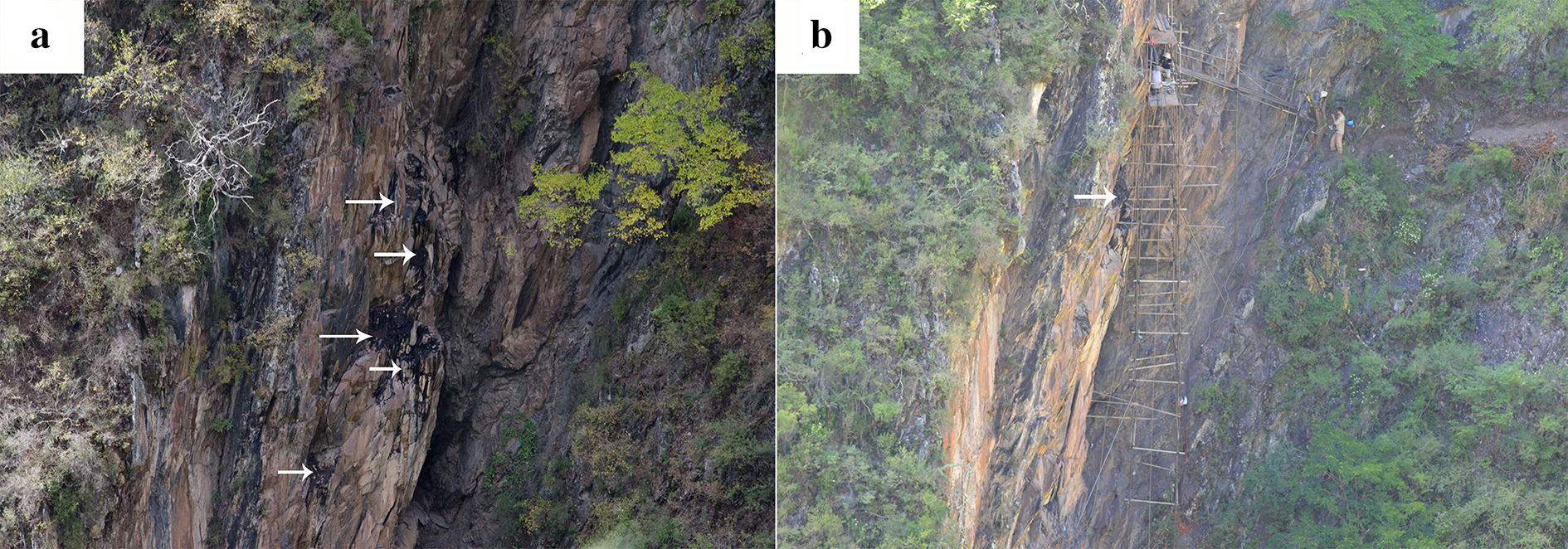
The location of the survey point and long-term observation point, white arrow pointed the point of seepage. (a and b were in the same position)
Geological environment study of Shilajit exudation points
Topography and geomorphology features of the Shilajit exudation points
Geomorphological types-The geological survey results of 74 Shilajit exudation points indicated that they were mainly distributed on steep slopes and steep cliffs with steep terrain. The exudation points were distributed in cliff cavities and section which could not be eroded by rainwater. It was consistent with the fact that strong tectonic activity, deep valley cutting and controlled structural plane development of the Songpan-Ganzi orogenic belt were observed in Shilajit points.
Distribution elevation- The investigated Shilajit exudation points were mainly distributed at an elevation of 2000–4000 m. Among them, 28, 24, 13 and 9 exudation points were located at an elevation of 2000–2500, 2500–3000, 3500–4000, and 3500–4000 m respectively.
Aspect- Mainly four groups of dominant aspects were observed, including: 1. NW 270°–280°; 2. NW 290°–300°; 3. NE 10°–20°. As shown in Fig. 2. These slopes were all sunny slopes, indicating that Shilajit tended to be exuded from sunny slope, which was consistent with the recorded of Tibetan classic ‘Jinzhu materia medica’ [31]. This result suggested heating effects of sunlight on rocks might be responsible for the exudation of Shilajit.
Fig. 2.
Slope feature of Shilajit exudation points
Geological structure and control structure surface of the Shilajit exudation points
The Shilajit exudation points were located in foreland basin of Bayan Kala-Songpan periphery in the Songpan-Ganzi orogenic belt. The foreland basin was connected to South Kunlun-Maqu-Ma-Qin belt in the north. The northeast was bounded by the Minjiang-Huya large-scale structure and the Pingwu–Qingchuan fault. South stopped at the Xianshui River fault structure and extended into Qinghai. Field geological survey results indicated that the control structural plane of Shilajit exudation location mainly included the following types:
Rock’s own structural plane control, fault plane, joint plane, etc. (Fig. 3), consisting the basic structure of Shilajit exudation points.
Unloading cracks and fault control (Fig. 4), such as: the broken rocks in developed areas of folds or faults form concave cavities and holes. There were distribution points of fault planes, joint planes and the places where Shilajit could be easily seeped out.
Concave cavity, wind erosion hole, steep cliff and other microgeomorphic control structure (Fig. 5). Concave cavity was a group of fault planes or joint planes formed by the falling off of rocks due to the action of gravity. Wind erosion holes were formed by wind erosion in softer parts of the rock. These holes were often the exudation area of joints or fault planes and also the exudation points of Shilajit.
Fig. 3.
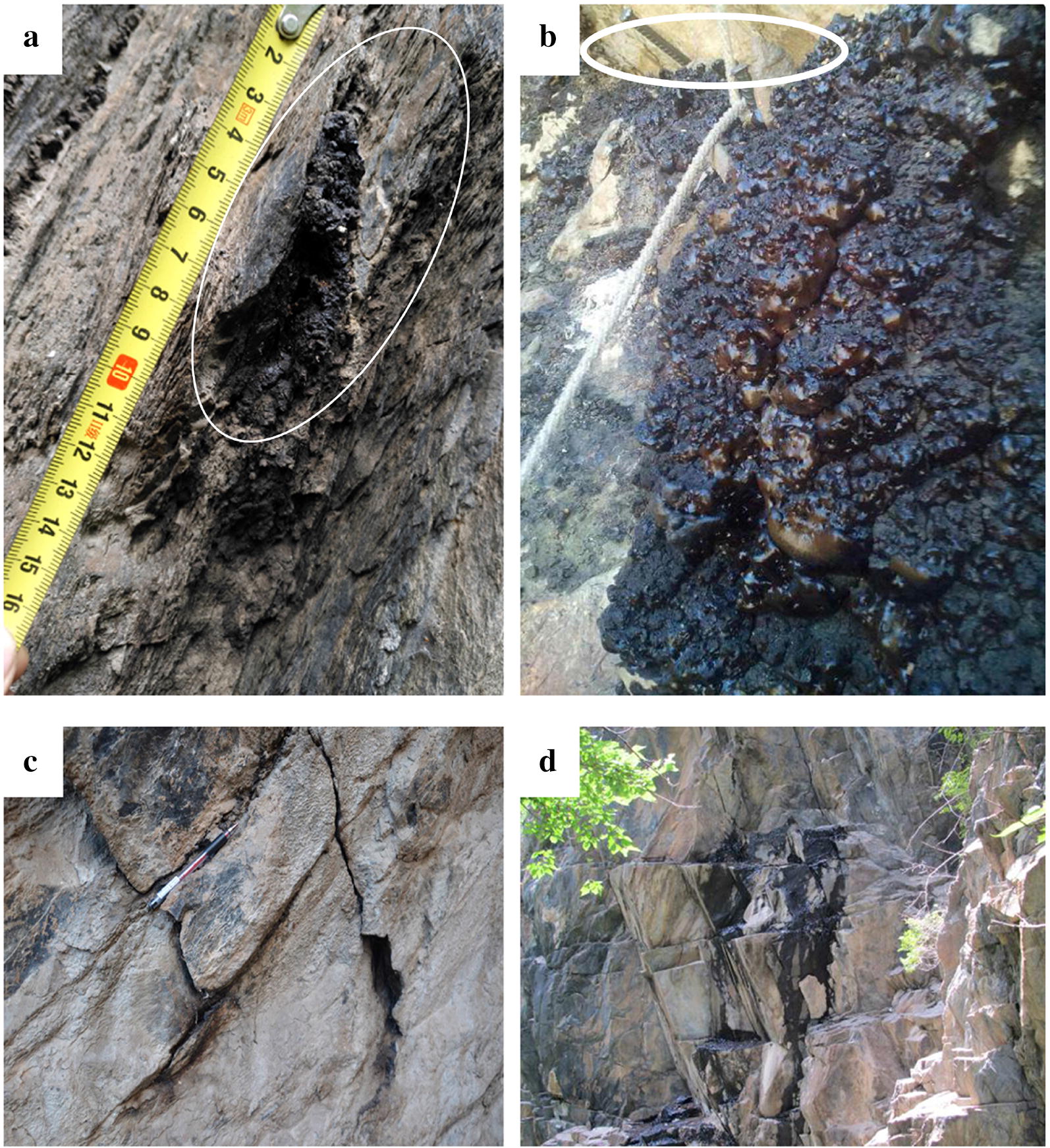
Controlled structural surface of the Shilajit exudation area (The black substance was Shilajit). a Fault plane. b Joint plane. c Joint plane. d Comprehensive structure of fault planes and joint planes
Fig. 4.
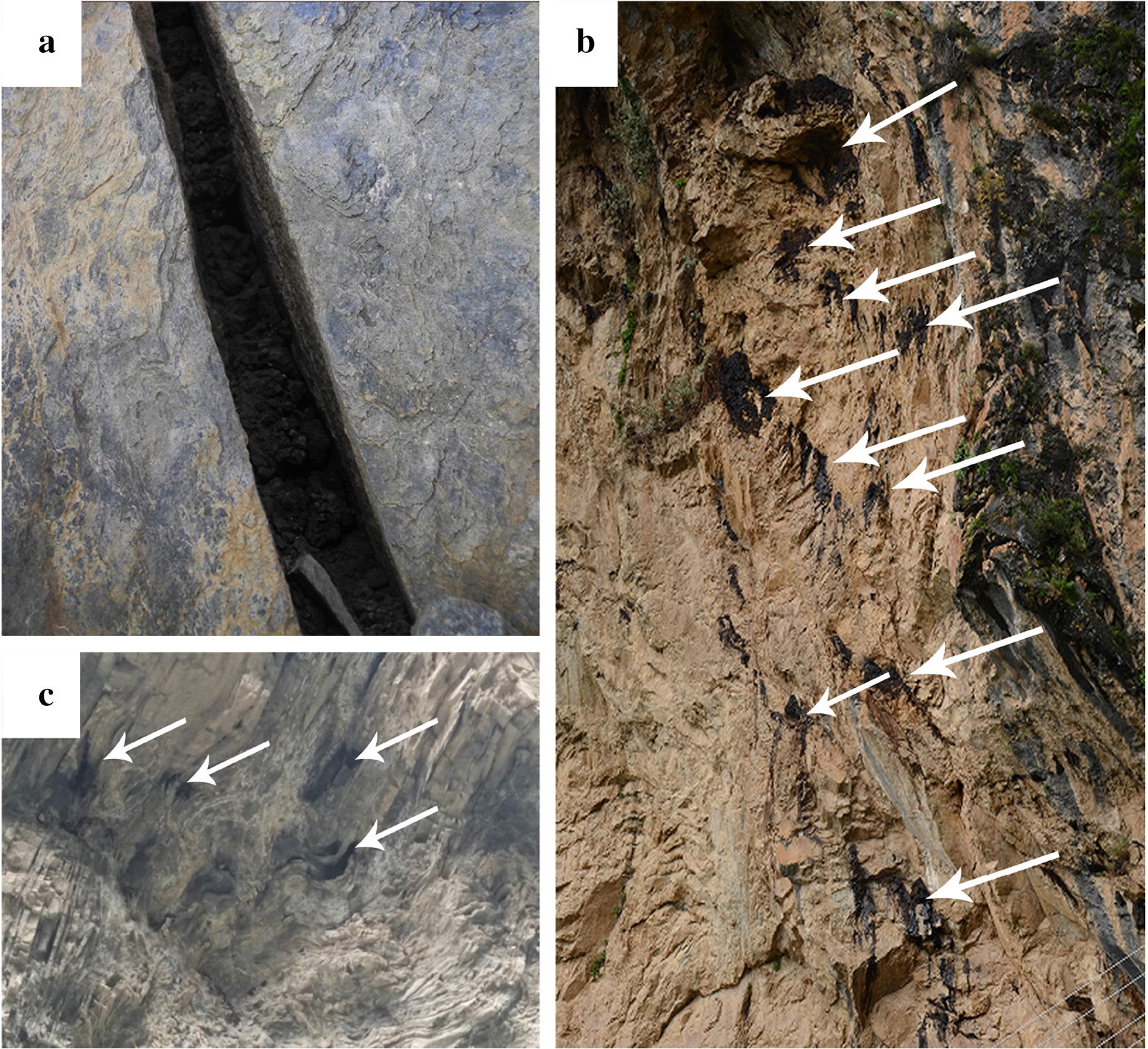
Unloading crack and fault structure of Shilajit exudation points, white arrow pointed the point of seepage. a Unloading crack. b Fault. c Fold
Fig. 5.
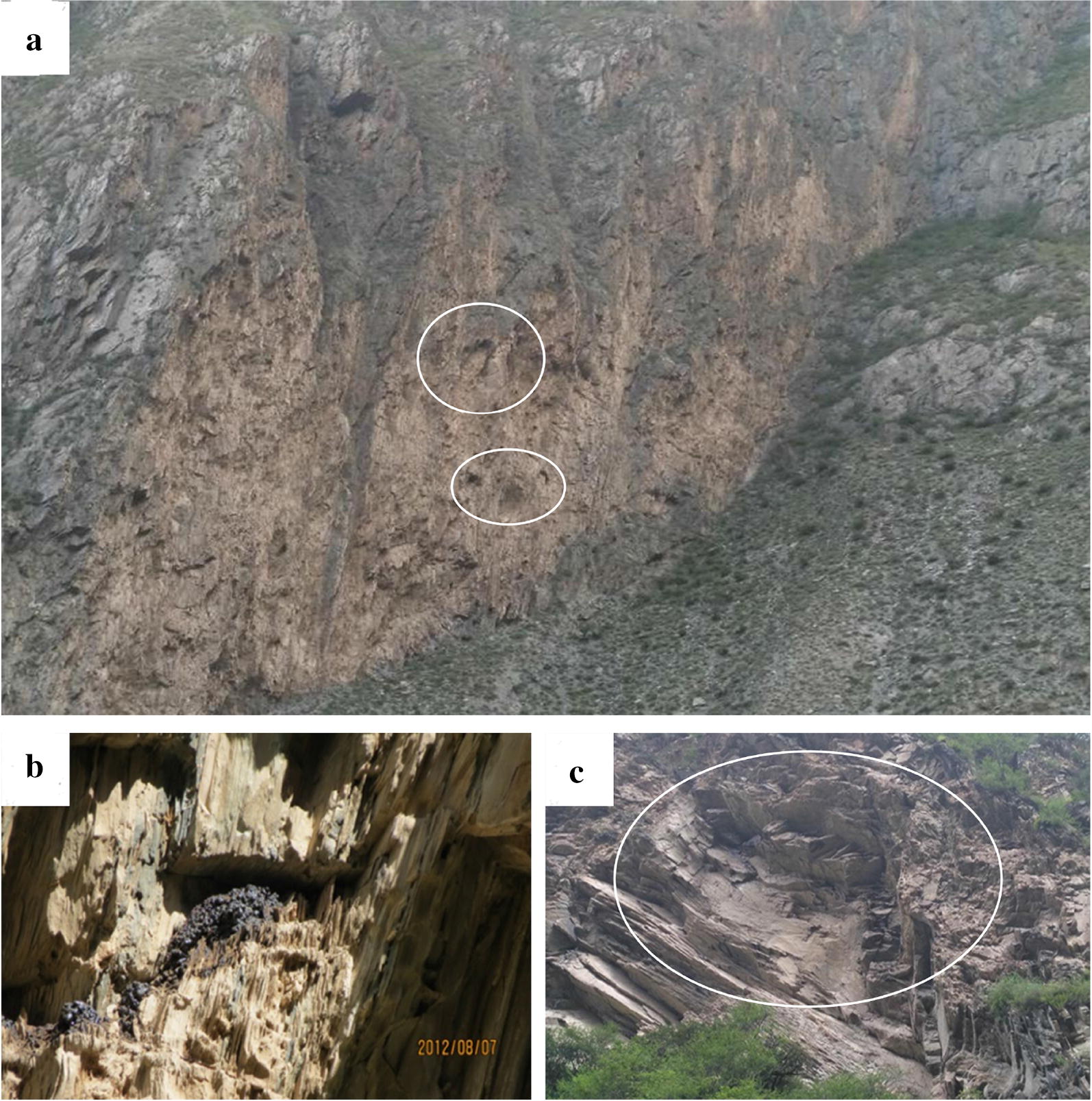
Micro-geomorphic type of Shilajit exudation points. a Wind erosion hole. b Concave cavity. c Concave cavity
It can be analyzed that exudation and formation of Shilajit were closely related to geological processes. Moreover, rock tectonic action led to storage environment (temperature, pressure, structural plane) changes, which in return caused the organic matter in the rock to naturally ooze along the pores, the structural surface, and even accumulate on the rock surface.
Geological background study of Shilajit exudation area
Geological structure and geological history analysis of the Shilajit exudation area
The strata of Shilajit exudation points were mainly distributed in Xinduqiao Formation (T3xd), Zhagashan + Zagunao Formation (T2-3zg-z), Zhuwo Formation (T3zh) and Yantang Formation (T1-2y) of the Triassic system, at the same time, there were sporadic distributions in the Early Mesozoic granites. The coordinate points and map data of Shilajit were imported into ArcGis10.5 software to generate Fig. 6, while the basic map data was provided by Institute of Geological Survey of Sichuan Provincial, China. Figure 6 showed the distribution of the Shilajit field survey points and the geological setting of the distribution area. The lithology character of T3xd included gray-black sericite slate, phyllite, metamorphic sandstone. The lithology character of T3zh included dark gray meta sandstone, sandstone and carbonaceous slate. The lithology character of T1-2y included dark gray bioclastic micrite.
Fig. 6.
Geological sketch of the Shilajit distribution area
The intrusive rocks of late Yanshanian were mainly composed of silicon, aluminum and supersaturated acid rocks. Characteristic trace elements of acid rock, such as Li, Be and Sn had higher content in these rocks, with good ore-bearing and potential mineralization prospects [32].
Geological background study of Shilajit exudation area
Identification of background rocks
Geological survey results of Shilajit exudation points indicated that lithologic characteristics of exudation area were mainly slate, carbonaceous slate, sandy slate, phyllite, meta sandstone, limestone and a small amount of granite.
The thin section identification of 17 batches of background rocks indicated that rock lithology mainly included silt-bearing fine sandstone, calcite quartz sericite phyllite, staurolite-bearing felsic sericite phyllite, metamorphic sandstone, silty metamorphic sandstone and (metamorphism) fine powder crystal dolomite. Among them, the samples lithology of Muerzong Township of Malcolm City, Mozigou of Danba County and Jiangda County of Tibet were characterized by granite (Table 2 and Fig. 7).
Fig. 8.
EDS results, the right picture was the analysis point
Table 2.
Thin section identification of background rocks
| No. | Autonomous Prefecture | Origin/source | Rock texture | Rock structure | Identification name |
|---|---|---|---|---|---|
| 1. | Ganzi | Dege County | Granoblastic texture | Massive structure | Calcite quartzite |
| 2. | Ganzi | Baisong Township, Derong County | Aplitic texture | Massive structure | (Metamorphism) Fine powder crystal dolomite |
| 3. | Ganzi | Donggu Township, Danba County | Lepido granoblastic texture | Phyllitic structure | Calcite quartz sericite phyllite |
| 4. | Ganzi | Danba County | Medium fine-grained blastogranitic texture | Massive structure | Metamorphic medium-fine grained two-mica adamellite |
| 5. | Aba | Cao Deng Township, Maerkang City | Lepido granoblastic texture | Phyllitic structure | Staurolite-bearing felsic sericite phyllite |
| 6. | Aba | Cao Deng Township, Maerkang City | Lepido granoblastic texture | Phyllitic structure | Staurolite-bearing felsic sericite phyllite |
| 7. | Aba | Longerjia Township, Maerkang City | Anisomerous blastopsammitic texture | Oriented structure | Metamorphic sandstone |
| 8. | Aba | Maerkang City | Aleuritic anisomerous blastopsammitic texture | Oriented structure | Silty metamorphic sandstone |
| 9. | Aba | Baiwan Township, Maerkang City | Lepido granoblastic texture | Parallel grain structure | Sillimanite-bearing two-mica granulite |
| 10. | Aba | Muerzong Township, Maerkang City | Medium-grained blastogranitic texture | Massive structure | Metamorphic medium-grained two-mica adamellite |
| 11. | Aba | Maerkang City | Medium fine-grained blastopsammitic texture | Oriented structure | Metamorphic medium-fine grained lithic arkose |
| 12. | Aba | Fubian Township, Xiaojin County | Fine-grained blastopsammitic texture | Oriented structure | Calcareous metamorphic fine sandstone |
| 13. | Aba | Xiaojin County | Fine-grained blastopsammitic texture | Oriented structure | Calcareous metamorphic fine sandstone |
| 14. | Aba | Dusong Township, Jinchuan County | Lepido granoblastic texture | Massive structure | Biotite granulite |
| 15. | Aba | Shili Township, Rangtang County | Aleuritic fine-grained blastopsammitic texture | Oriented structure | Silty-bearing metamorphic fine sandstone |
| 16. | Aba | Heishui County | Blastopsammitic texture | Platy structure | Metamorphic sandstone |
| 17. | Tibet | Jiangda County | Fine-grained granitic texture and breccia texture | Massive structure | Brecciated tonalite |
Fig. 7.
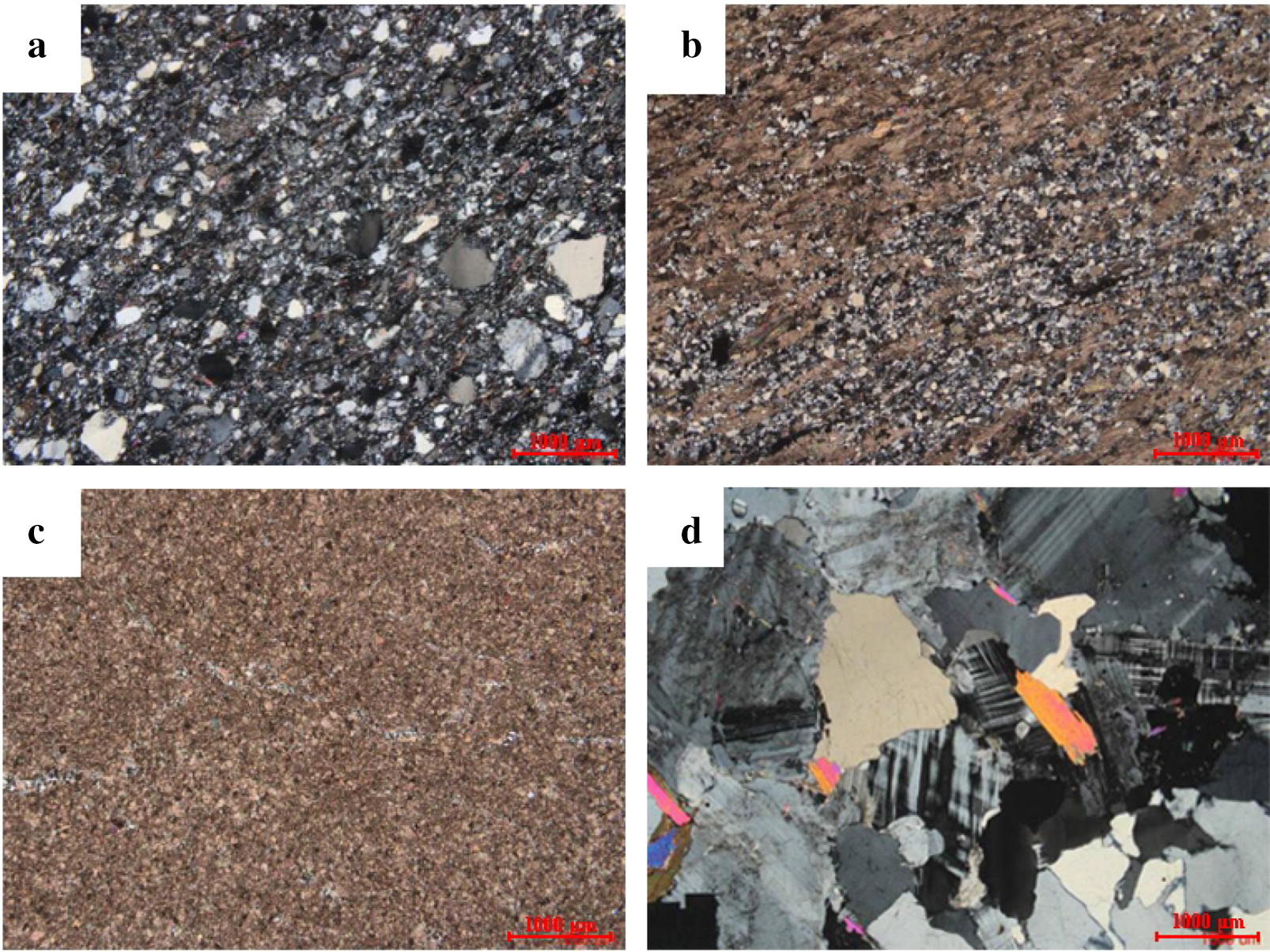
Typical results of thin section identification of Shilajit background rocks. a Rock samples from Longerjia Township, Maerkang City, Aba Autonomous Prefecture, Sichuan Province, anisomerous blastopsammitic texture. b Rock samples from Dege County, Ganzi Autonomous Prefecture, Sichuan Province, granoblastic texture. c Rock samples from Derong County, Ganzi Autonomous Prefecture, Sichuan Province, Aplitic texture. d Rock samples from Muerzong Township, Maerkang City, Aba Autonomous Prefecture, Sichuan Province, Medium-grained blastogranitic texture
Among them, the sandstone and phyllite had high sand content. The rock may have pores, and there was possibility of storing organic matter and water. Since Shilajit can be easily dissolved in water and phyllite is a waterproof barrier, the rock showed natural condition of storing Shilajit. Because granite is an intrusive igneous rock, there is no pore development, but there may be possibility of storing organic matter in its fissures and joints.
Determination of organic carbon and TOC
The tests were conducted in accordance with the China National Standard DZG20.01-1991. Comparing to regular rocks, the background rocks containing Shilajit had significantly higher organic carbon content, as shown in Table 3, indicating that organic matter in Shilajit might be derived from background rocks.
Table 3.
Organic carbon content TOC in Shilajit background rocks
| Producing area | Results (%) | |
|---|---|---|
| Organic carbon | TOC | |
| Cao Deng Township, Maerkang City, Aba Prefecture B-b | 0.930 | 1.120 |
| Cao Deng Township, Maerkang City, Aba Prefecture E-b | 0.905 | 1.120 |
| Longerjia Township, Maerkang City, Aba Prefecture | 1.000 | 1.110 |
| Maerkang City, Aba Prefecture | 0.265 | 0.345 |
Background rock SEM and EDS
EDS of 35 samples showed that content of organic matter in pores and cracks of the background rock was between 8.29 and 89.04%. It contained elements including C, N, O, Na, Al, Si, Cl, Ca, S, K, Ti, Mg and Fe, with a large proportion of C, O, Al, Si and K. The results of SEM showed that these organic matters were attached to surface of minerals. Table 4 and Table 5 only showed samples with C element content greater than 40%.
Table 4.
EDS results (Element C > 40%)
| Source | Elemental quality (%) | EDS results | |||||||||
|---|---|---|---|---|---|---|---|---|---|---|---|
| C | N | O | Na | Al | Si | Cl | S | K | Ca | ||
| Mozigou, Danba County | 40.83 | 15.4 | 34.67 | 2.02 | 1.00 | 3.50 | 1.27 | 0.23 | 1.1 | Shown in Fig. 8a | |
| Muerzong Township, Maerkang City | 44.10 | 37.63 | 2.98 | 1.41 | 2.73 | 6.43 | 3.29 | 1.44 | Shown in Fig. 8b | ||
| Longerjia Township, Maerkang City | 41.03 | 42.06 | 3.19 | 5.74 | 5.24 | 1.96 | 0.78 | Shown in Fig. 8c | |||
Table 5.
Analysis results of EDS characteristics with organic carbon content greater than 40%
| Sample number | C (%) | N (%) | O (%) | Na (%) | Al (%) | Si (%) | Cl (%) | Ca (%) | S (%) | K (%) | Ti (%) | Mg (%) | Fe (%) |
|---|---|---|---|---|---|---|---|---|---|---|---|---|---|
| DBM-3-018 | 40.83 | 15.40 | 34.67 | 2.02 | 1.00 | 3.50 | 1.27 | 0.23 | 1.10 | ||||
| DBM-1-002 | 45.55 | 40.78 | 3.11 | 1.64 | 3.95 | 2.77 | 0.64 | 1.56 | |||||
| DBM-1-003 | 50.02 | 27.94 | 2.12 | 1.37 | 5.30 | 0.92 | 2.46 | ||||||
| DBM-1-006 | 49.10 | 32.80 | 3.49 | 4.85 | 4.26 | 5.50 | |||||||
| MEK-b-1-003 | 44.10 | 37.63 | 2.98 | 1.41 | 2.73 | 6.43 | 1.44 | 3.29 | |||||
| MEK-b-1-004 | 40.86 | 9.28 | 37.92 | 3.54 | 0.52 | 1.62 | 3.56 | 0.78 | 1.92 | ||||
| MEK-b-3-001 | 89.04 | 2.68 | 2.90 | 1.56 | 3.82 | ||||||||
| LEJ-2-003 | 41.03 | 42.06 | 3.19 | 5.74 | 5.24 | 1.96 | 0.78 |
DBM Mozigou, Danba County, MEK Muerzong Township, Maerkang City, LEJ Muerzong Township, Maerkang City
Spatial analysis of organic carbon storage in background rocks
According to observation of casting thin section, the reservoir space of rock mainly included intergranular pores, intragranular pores, intercrystalline pores, intracrystalline pores, tectonic fracture, jointed cracks and a small number of dissolved pores. Most of the pores and cracks were semi-filled or completely filled with dark organic matter. SEM and EDS showed that organic matter was not only filled in pores and cracks, but also attached to the mineral surface, indicating that background rocks were rich in organic matter. Porosity test results were present in Table 6.
Table 6.
Porosity analysis results
| No. | Sample ID | Porosity (%) |
|---|---|---|
| 1. | LEJ-1 | 2.1 |
| 2. | LEJ-2 | 2.5 |
| 3. | GED-1 | 1.3 |
| 4. | GED-2 | 0.9 |
| 5. | DBMZ-1 | 1.9 |
| 6. | DBMZ-2 | 1.5 |
LEJ Longerjia Township, Maerkang City, GED Gaoerda Village, Maerkang City, DBMZ Mozigou, Danba County
The intergranular pores and dissolved pores were organic storage pores, both of which were filled with visible organic matter. The cracks and joints were not only reservoir space, but also transport channel for organic matter. This result showed that background rocks of Shilajit were capable to storage and transport organic carbon. The background rock may be the original source of Shilajit exudation, which was storage place of organic matter in Shilajit. As shown in Figs. 9 and 10.
Fig. 9.
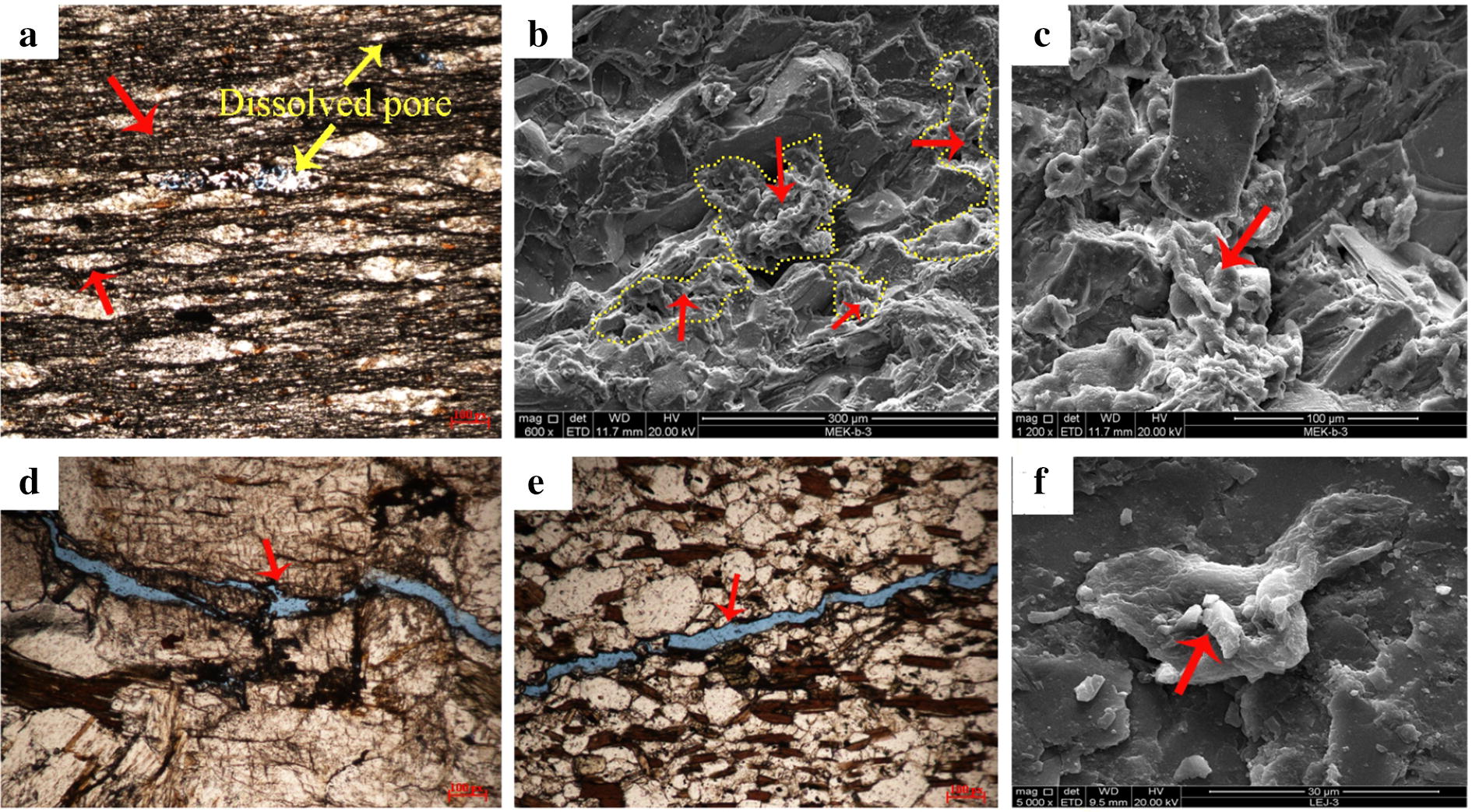
Development of intergranular pores in Maerkang City, Aba Autonomous Prefecture. a Longerjia Township, dissolved pore in grains. b Baiwan Township, intercrystalline pore and dissolved pore in grains. c Baiwan Township, organic matter filling intergranular pore. d Muerzong Township, structural fractures and intercrystalline dissolution pore. e Baiwan Township, structural fractures and intergranular pores. f Baiwan Township, organic matter attached to the mineral surface
Fig. 10.
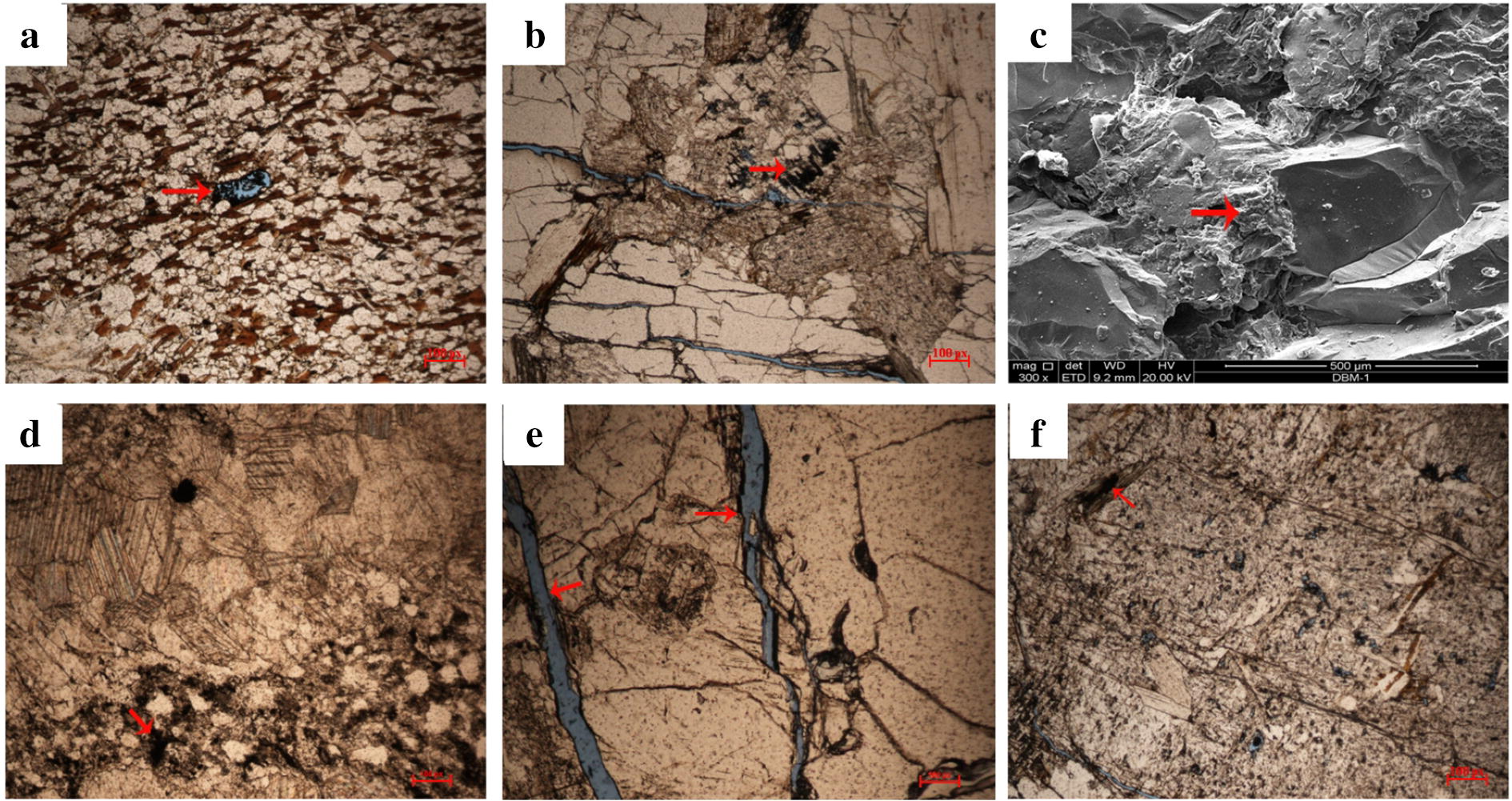
Denudation pores development and cracks, joints. a Baiwan Township, Maerkang City, mica denudation. b Muerzong Township, Maerkang City, feldspar denudation. c Fubian Township, Xiaojin County, denudation. d Fubian Township, Xiaojin County, organic matter filling denudateon pore. e Muerzong Township, Maerkang City, crack. f Mozigou, Danba County, joint development, filled with black organic matters
Discussion
According to the dynamic characteristics of Shilajit exudation area, the paleogeographic environment of sedimentary tectonic structure was Triassic tectonic paleogeographic pattern, which belonged to the residual ocean basin (OB)-spreading ridge (Sr) environment in ocean basin. The sedimentary environment of Triassic was characterized by gradual evolution of shelf slopes and shelf ridges, semi-deep sea slope valleys and slope fans (skirts) in terrigenous clastic shallow sea. At the end of the Triassic, due to collisional orogeny on north side, the ocean basin was closed. The paleogeographic features in the area were transformed into intracontinental environment, which was transformed into Late Triassic foreland basin and developed a thick turbidite system. The sedimentary environment of deposits was alluvial fan-river facies, and the latter was dominated by reticulated rivers. The Yanshanian medium-acid magmatic intrusive activity was strong, and the late Yanshanian intrusive rock was mainly distributed in the stress concentration area or regional fault activity zone [33].
The stratigraphic sequence of Shilajit exudation area was incomplete. While the Triassic strata were mainly distributed in large areas in sedimentary basins, and the Triassic rock combination was dominated by thick semi-deep sea turbidites and contourite (sand slate). In the early and late periods, some distant Yuanbin mudstone, siltstone and sandstone were distributed. After entering the Cenozoic, when marine environment was over, a small fault basin accumulation was formed, representing by river glutenite, siltstone and mudstone combination, and river–lake-phase coal-bearing clastic rock combination.
According to the geological and historical background, combined with the analysis of the research results, the formation mechanism of Shilajit was somewhat complicated. There were several possibilities, which need further confirmation by geochemical research.
The Shilajit organic matter in the rock formation was evolved from the remains of paleontology. The organic matter was formed in the early Triassic marine layered environment. However, at the end of the Triassic period, the paleogeographic features in the distribution area were transformed from the marine environment to the intracontinental environment, which changed the original environment of high temperature and high pressure, preventing the organic matter from continuing to evolve.
It may be thermally evolved from mudstones and muddy sandstones adjacent to the mother rock. After the Triassic, the distribution area was mainly the fold uplift period, and the burial heat evolution was basically eliminated, mainly due to the invasion of the granite slurry, resulting in thermal evolution. For example, the shale content of the exudation points of Longerjia Township, Maerkang City was relatively higher. Mainly argillaceous sandstone and sandy mudstone, some organic matter was attached to the mineral surface, which had certain similarities with the oil and gas enrichment on the surface of shale minerals. Therefore, the Shilajit organic matter may be derived from organic rich mudstone.
It may also be derived from granitic magmatic differentiation. Magmatic activity was closely related to hydrocarbon accumulation and mineralization. The Songpan–Ganzi terrane after the large-scale Indosinian orogeny was affected by the remote effect of the Indian-Asia collision [34, 35]. The Indosinian granitoids (Paleozoic strata and Neoproterozoic crystalline basement) were widely exuded from the Maerkang-Daba sub-terrane (Main exudation area of Shilajit) in the northeast and the Yajiang-Muli sub-terrane in the southwest, these emplacement granitoids were produced by the dome group, which are characterized by zonal distribution in the near north–south direction. Such as the Danba Dome Group and the Muli Dome Group [36]. The main exudation zone of Shilajit had a certain coupling relationship with the spatial distribution of the early Mesozoic granite and the derived pegmatite emplacement, especially in the Maerkang-Daba sub-terrane. The Shilajit exudation points were mostly located in the northeast and southeast of Songpan-Ganzi, where strong magmatic action was observed.
Conclusion
In this study, it was found that Shilajit mainly distributed on sunny steep slopes and cliffs with a slope of 60° or above at altitude of 2000–4000 m. The control structure surface of the exudation points included rock layer, joint, fracture surface, fault control, and it developed into micro-geomorphology such as concave cavity, wind erosion hole and steep cliff.
The lithology character of the Shilajit exudation area were mainly various metamorphic rocks of sedimentary rocks and a small amount of granite in the Yanshanian period that were rich in organic carbon. Some of rocks developed into intergranular pores, dissolution pores, cracks and joints for storing and transporting organic matter. The organic matter in Shilajit was found to flow out naturally from rocks along pore, structural plane and even accumulate on the surface of rock as a result of storage environment (temperature, stress, structural surface) change caused by rock tectonic action. Further geochemical research is required to confirm the source of organic matter in rocks.
Acknowledgements
Not applicable.
Abbreviations
- SEM
Scanning electron microscopy
- EDS
Energy dispersive spectrometer
- TOC
Total organic carbon
Authors’ contributions
RG, SZ organized and designed the study. RD, RG, MZ, JF, MW participated in field investigations. MW gave a geological description. RD, XH performed experimental work and data processing. RD, MZ, RG wrote the manuscript and prepared the figures. MZ revised the manuscript. All authors read and approved the final manuscript.
Funding
This research was funded by the National Natural Science Foundation of China (No. 83571699), and innovation fund project of Jiangxi (No. JXXT201402008-1).
Availability of data and materials
All data used to support the findings of this study are available from the corresponding author upon request.
Ethics approval and consent to participate
Not applicable.
Consent for publication
Not applicable.
Competing interests
The authors declare that they have no competing interests.
Footnotes
Publisher's Note
Springer Nature remains neutral with regard to jurisdictional claims in published maps and institutional affiliations.
Rong Ding and Mingming Zhao contributed equally to this work
Contributor Information
Shihong Zhong, Email: 527455247@qq.com.
Rui Gu, Email: 664893924@qq.com.
References
- 1.Frolova LN, Kiseleva TL. Chemical composition of mumijo and methods for determining its authenticity and quality (a review) Pharm Chem J. 1996;30:543–547. doi: 10.1007/BF02334644. [DOI] [Google Scholar]
- 2.Thiyagarajan R, Sunderrajan A. Gunapadam Thathu Jeeva Vaguppu, fourthed. Chennai: Directorate of Indian Medicine and Homeopathy; 1992. [Google Scholar]
- 3.Suo Nan DD, Tong L, Yuan DP, Re Zeng CD. Literature research on traditional Tibetan medicine Shilajit. Zhongguo Min Zu Min Jian Yi Yao. 2012;2:8–9. [Google Scholar]
- 4.Zhong GY, Zhou FC, Shi SM, et al. Actuality investigation on general crude drugs and its quality standard of Tibetan medicine. Zhongguo Zhong Yao Za Zhi. 2012;37:2349–2355. [PubMed] [Google Scholar]
- 5.Kizaibek M. Research advances of Tasmayi. Zhongguo Zhong Yao Za Zhi. 2013;38:443–448. [PubMed] [Google Scholar]
- 6.Zhao MM, Gu R, Fan JY, et al. Research progress of Tibetan medicine ‘Zha-xun’. Zhongguo Zhong Yao Za Zhi. 2018;43:1554–1562. doi: 10.19540/j.cnki.cjcmm.20180122.001. [DOI] [PubMed] [Google Scholar]
- 7.Agarwal SP, Khanna R, Karmarkar R, Anwer MK, Khar RK. Shilajit: a review. Phytother. Res. 2007;21:401–405. doi: 10.1002/ptr.2100. [DOI] [PubMed] [Google Scholar]
- 8.Kwon BS, Khlebnikov AI, Schepetkin, Woo SB. Fulvic acid fractions from mumie. Proceedings. The 8th Russian-Korean International Symposium on Science and Technology, 2004. KORUS 2004. p. 352–355. 10.1109/KORUS.2004.1555783.
- 9.Garedew A, Feist M, Schmolz E, Lamprecht I. Thermal analysis of mumiyo, the legendary folk remedy from the Himalaya region. Thermochim Acta. 2004;417:301–309. doi: 10.1016/j.tca.2003.09.034. [DOI] [Google Scholar]
- 10.Eugene WG, Victor RG, Prasad D, et al. Review on shilajit used in traditional Indian medicine. J Ethnopharmacol. 2011;136:1–9. doi: 10.1016/j.jep.2011.04.033. [DOI] [PubMed] [Google Scholar]
- 11.Bowman WR, Mann E, Parr J, et al. Bu3SnH mediated oxidative radical cyclisations: synthesis of 6H-benzo (c)chromen-6-ones. J Chem Soc Perkin Trans. 2000;1:2991–2999. doi: 10.1039/B002539I. [DOI] [Google Scholar]
- 12.Khalikov SK, Alieva SV. Isolation of vitamin D3 from natural mumiyo. Chem Nat Compounds. 2003;39:410. doi: 10.1023/B:CONC.0000003431.01388.09. [DOI] [Google Scholar]
- 13.Ghosal S. Shilajit in Perspective, first ed. Alpha Science International Limited, Oxford. 2006. https://www.amazon.com/Shilajit-Perspective-S-Ghosal/dp/184265313X.
- 14.Ma SL, Luo DS, Mao JZ, et al. translation. Rgyud-bzhi: Shanghai Science and Technology Publishing House, Shanghai, China; 1987. [Google Scholar]
- 15.Sudarshan SR. Encyclopedia of Indian Medicine: Materia medical ‘Mineral and Metallic Drugs’ Parameshvara Charitable Trust. India: Bangalore; 2005. [Google Scholar]
- 16.Scholz-Böttcher BM, Nissenbaum A, Rullkötter J. Mumie-the‘blood of mountains’: an analytical approach. 2005. http://www.ogc.icbm.de/poster/Miscellaneous/Scholz-Boettcher2005-IMOG-Mumiethe%20Blood%20of%20Mountains.pdf.
- 17.Northwest Plateau Institute of biology . Chinese Academy of Sciences. Tibetan medicine. Xining: Qinghai People’s Publishing House; 1991. [Google Scholar]
- 18.Gao SX, Deng ML. Ecological observation of Trogopterus xanthipes and formation of mixture of urine and feces. Special Wild Econ Anim Plant Res. 1983;3:28–29. [Google Scholar]
- 19.Cao Y. Pharmacognosy research on Tibetan medicine ‘shilajit’. Sichuan: Chengdu University of Traditional Chinese Medicine; 2015. [Google Scholar]
- 20.Zhou QW, Fu CC. Discussion on the evolution mode of organic matter hydrocarbon format. Sichuan Jian Cai. 2017;43:71–72. [Google Scholar]
- 21.Xu ZH, Du Y, Shi SL, et al. Geographical distribution and damage degree of Monochamus alternatus in Yunnan province. Xinan Lin Ye Da Xue Xue Bao. 2010;30:37–43. [Google Scholar]
- 22.Qin BS, Wang MF, Zhong RY, et al. Classification and nomenclature schemes of igneous rock. State administration for market regulation: Standards Press of China; 1998. [Google Scholar]
- 23.Yang L, Hang GM, Wang MF, et al. Classification and nomenclature schemes of sedimentary rock. State administration for market regulation: Standards Press of China; 1998. [Google Scholar]
- 24.Zhong RY, Wang MF, Yang L, et al. Classification and nomenclature schemes of metamorphic rock. State administration for market regulation: Standards Press of China; 1998. [Google Scholar]
- 25.Dong GX, Zheng CJ, Wu GM, et al. Specification of rock and mineral-Part1: General rules and regulation. Beijing: Ministry of Land and Resources of the People’s Republic of China; 2015. [Google Scholar]
- 26.Wu GM, Hu YP, Bian ZH, et al. Specification of rock and mineral-Part4: Thin section identification of rock. Beijing: Ministry of Land and Resources of the People’s Republic of China; 2015. [Google Scholar]
- 27.Yin M, Wang SM, Ye JY, et al. The Specification of testing quality management for geological laboratories. Beijing: Ministry of Land and Resources of the People’s Republic of China; 2006. [Google Scholar]
- 28.Xiong JH, Shi BS. The specification of testing quality management for geological laboratories. Beijing: Ministry of Land and Resources of the People’s Republic of China; 1994. [Google Scholar]
- 29.Lorimer GW, Cliff G. Analytical Electron Microscopy of Minerals. Electron Microscopy in Mineralogy. 1976 doi: 10.1007/978-3-642-66196-9_38. [DOI] [Google Scholar]
- 30.Yang SL. Fundamentals of Petrophysics. Beijing: Petroleum industry publishing house; 2011. [Google Scholar]
- 31.Mao JZ, Luo SD, Wang ZH. translation. Jinzhu materia medica: Shanghai Science and Technology Publishing House, Shanghai, China; 1988. [Google Scholar]
- 32.Wang X, Zhou XH, Xu GS, et al. Characteristics and controlling factors of reservoirs in Penglai 9-1 large-scale oilfield in buried granite hills, Bohai sea. Shiyou Yu Tian Ran Qi Di Zhi. 2015;36:262–270. [Google Scholar]
- 33.Zhao ZJ, Gu YJ, Shi YP, et al. Study and application of granite reservoirs reconstruction technology in Wulanhua sag, Erlian basin. Zhongguo Kuang Ye. 2019;28:72–76. [Google Scholar]
- 34.Xu ZQ, Hou LW, Wang ZX. The orogenic process of the Songpan-Ganzi orogenic belt in China. Beijing: Geological Publishing House; 1992. [Google Scholar]
- 35.Roger F, Malavielle J, Leloup PH, Calassou S, Xu ZQ. Timing of granite emplacement and cooling in the Songpan-Garzê Fold Belt (eastern Tibetan Plateau) with tectonic implications. J Asian Earth Sci. 2004;22:465–481. doi: 10.1016/S1367-9120(03)00089-0. [DOI] [Google Scholar]
- 36.Xu ZQ, Fu XF, Zhao ZB, et al. Discussion on relationships of Gneiss Dome and Metallogenic regularity of Pegmatite-Type lithium deposits. Di Qiu Ke Xue. 2019;44:1452–1463. [Google Scholar]
Associated Data
This section collects any data citations, data availability statements, or supplementary materials included in this article.
Data Availability Statement
All data used to support the findings of this study are available from the corresponding author upon request.



